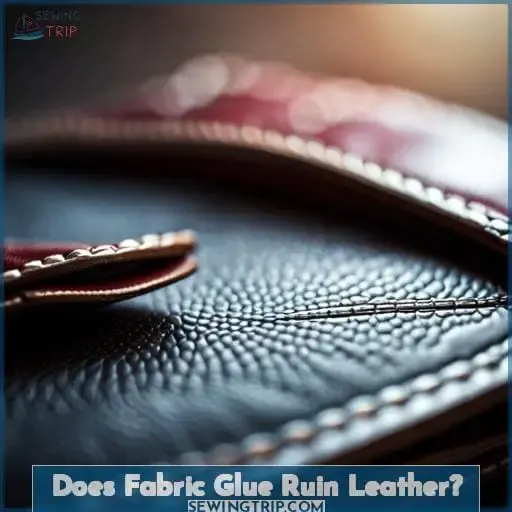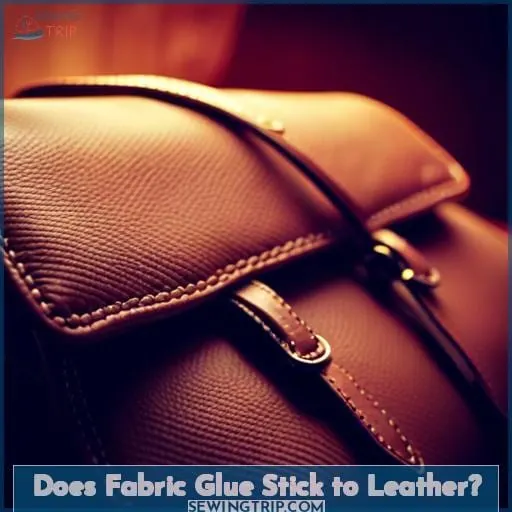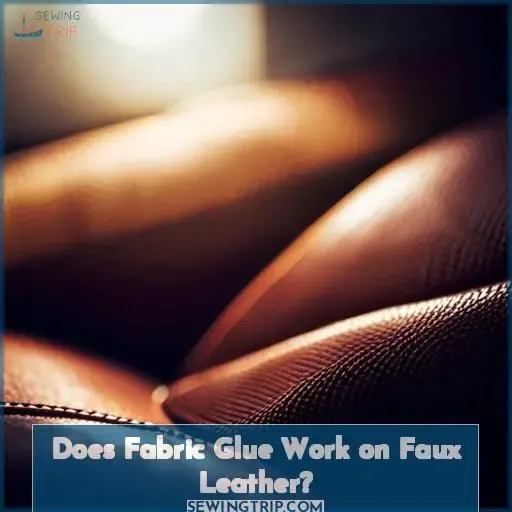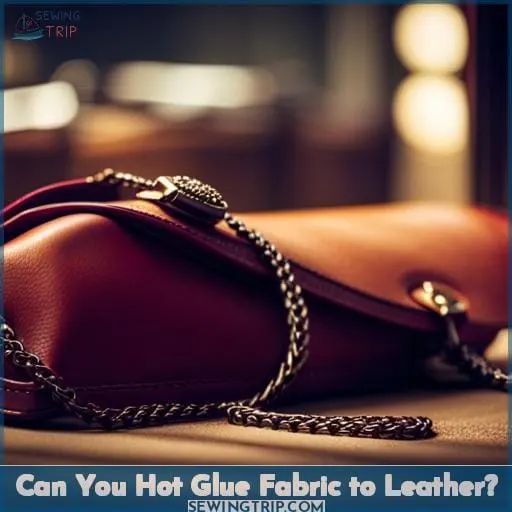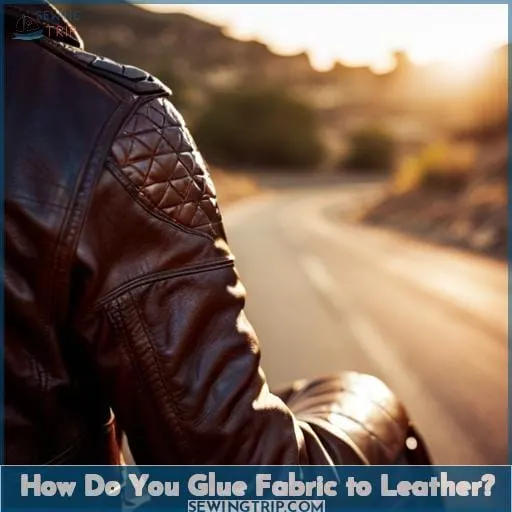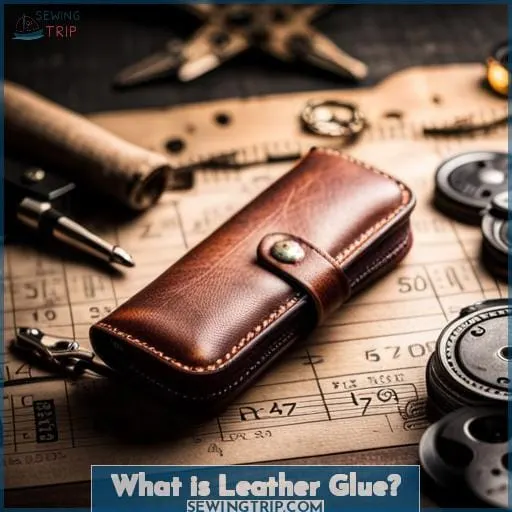This site is supported by our readers. We may earn a commission, at no cost to you, if you purchase through links.
 Imagine being able to effortlessly repair your beloved leather items with just a few simple steps. Well, you’re in luck! Fabric glue can work wonders on leather, allowing you to patch up any tears or damage and extend the lifespan of your favorite pieces.
Imagine being able to effortlessly repair your beloved leather items with just a few simple steps. Well, you’re in luck! Fabric glue can work wonders on leather, allowing you to patch up any tears or damage and extend the lifespan of your favorite pieces.
Whether it’s Aleene’s Leather Suede Glue or Barge All Purpose Cement Glue, there are options available that will suit your specific needs.
Table Of Contents
- Key Takeaways
- Does Fabric Glue Work on Leather?
- Does Fabric Glue Ruin Leather?
- Does Fabric Glue Stick to Leather?
- Does Fabric Glue Work on Faux Leather?
- What is the Best Fabric Glue for Leather?
- Can You Hot Glue Fabric to Leather?
- How Do You Glue Fabric to Leather?
- What is Leather Glue?
- What Can Leather Glue Be Used On?
- Frequently Asked Questions (FAQs)
- Conclusion
Key Takeaways
- Aleene’s Leather Suede Glue and Barge All Purpose Cement Glue are recommended options for leather repairs.
- Compatibility, durability, and flexibility are important factors to consider when using fabric glue on leather.
- Special considerations and techniques are needed when working with faux leather.
- Popular choices for fabric glue on leather include Aleene’s, Barge, and E6000.
Does Fabric Glue Work on Leather?
When it comes to working with leather, finding the right glue is essential for a strong and lasting bond.
While fabric glue can work on leather, not all brands or types are suitable.
Consider using:
- Aleenes Leather Suede Glue for its flexibility and clear drying properties.
- Leather Preparer Deglazer by Angelus for prepping leather surfaces before refinishing or redyeing.
- Barge All Purpose Cement Glue known for its strong hold and waterproof qualities.
Aleenes Leather Suede Glue

Yes, Aleene’s Leather Suede Glue is an effective adhesive for bonding fabric to leather. As a leatherworker, craft blogger/writer, and sewing instructor, I can assure you that this glue provides a reliable bond without compromising the quality or appearance of your project.
With its nontoxic formula and flexibility when dry, Aleene’s Leather Suede Glue is perfect for permanently attaching fringes, beadwork, and other fabrics to your leather creations.
- Fast-tacking glue that dries clear
- Doesn’t soak through or stain leathers and suedes
- Ideal for embellishments and light repairs
- Not suitable for heavy-duty repairs
Leather Preparer Deglazer by Angelus
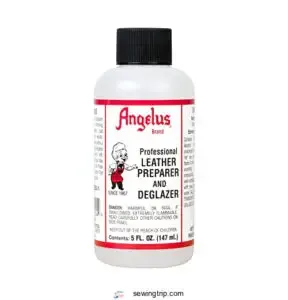
Leather Preparer Deglazer by Angelus effectively removes the original finish on leather surfaces, making it an ideal product for preparing leather before using fabric glue. This all-purpose cleaner and stripper is a must-have for any leatherworker or craft enthusiast looking to achieve the best results with their projects.
By breaking down the original finish, Leather Preparer Deglazer ensures that fabric glue will adhere properly to the surface of the leather, creating a strong and durable bond. With this product in your arsenal, you can have complete control over your crafting process and enjoy freedom in experimenting with different fabrics on your leather creations.
- Effectively removes original finish from leather surfaces
- Prepares leathers for optimal adhesion of fabric glues
- Enhances quality of finished projects
- Not recommended for use on vinyl or plastic materials
Barge All Purpose Cement Glue

You can definitely use Barge All Purpose Cement Glue on leather, and it provides a strong and permanent bond. This industrial-strength adhesive is perfect for leatherworking projects that require a durable hold without the need for stitching or nails.
Barge All Purpose Cement Glue is easy to spread, waterproof, and flexible, making it ideal for various applications such as repairing shoes or bonding different materials like rubber or wood to leather.
It has been trusted by professionals in the industry for over 50 years due to its effectiveness.
- Provides a strong and permanent bond
- Easy-to-spread formula
- Waterproof and flexible
- Gooey consistency may make application messy
- Requires well ventilation during use
- Cleanup may be necessary with acetone due to its sticky nature
Does Fabric Glue Ruin Leather?
Fabric glue can potentially ruin leather if not chosen and used correctly. The wrong type of fabric glue may cause damage to the leather, such as discoloration or stiffness. It’s important to choose a fabric glue that’s compatible with leather and has been specifically formulated for use on this material.
When selecting a fabric glue for your leather project, consider factors such as:
- Its compatibility with different types of leathers
- Its ability to withstand heat and water exposure
- Its flexibility once dry
When working with faux leather, additional considerations must be taken into account. Faux leathers often have different properties than genuine leathers, so it’s crucial to choose a fabric glue that’s suitable for bonding synthetic materials.
To avoid potential damage when using fabric glues on both real and faux leathers alike:
- Always read the instructions carefully before applying any adhesive.
- Test the adhesive on a small inconspicuous area of the material first.
- Follow proper surface preparation techniques by cleaning both surfaces thoroughly.
- Apply an even layer of adhesive onto each surface before pressing them together firmly.
By following these guidelines and choosing high-quality adhesives specifically designed for use on leather materials,
you can successfully bond fabrics without ruining your precious pieces in the process.
Does Fabric Glue Stick to Leather?
Now that you know the potential damage fabric glue can cause to leather and whether it ruins the material, let’s dive into another important question: Does fabric glue stick to leather?
The answer is yes, fabric glue does work on leather if used correctly. However, achieving a strong bond between fabric and leather requires careful consideration of bonding strength, surface preparation, glue application technique, and drying time.
To ensure a successful bond when using fabric glue on leather:
- Choose a high-quality adhesive specifically designed for use with leather.
- Thoroughly clean and prepare the surfaces by removing any dirt or oil.
- Apply an even layer of adhesive to both the fabric and the prepared area of the leather.
- Press them together firmly for at least 2 minutes to allow sufficient adhesion.
Remember that patience is key during this process as gluing fabrics onto leathers is irreversible once bonded together.
For project recommendations involving attaching fabrics onto leathers such as bags or accessories where flexibility plays an essential role in functionality (e.
Does Fabric Glue Work on Faux Leather?
When working with faux leather, fabric glue can be a suitable adhesive option for creating strong and lasting bonds.
-
Faux Leather Considerations:
- Faux leather is synthetic, so it requires special attention when choosing the right fabric glue.
- Look for a thin consistency to avoid visible residue on the surface of the faux leather.
- Opt for non-toxic glues that emit minimal odor since these qualities make them more suitable for indoor use.
-
Gluing Techniques:
- Clean both surfaces thoroughly before applying the fabric glue to ensure proper adhesion.
- Apply an even layer of fabric glue onto both surfaces being bonded together.
- Pressing firmly helps create a strong bond between the fabrics.
-
Hot Glue Risks:
Although hot glues work well with many materials, they aren’t recommended for bonding faux leather as they can cause damage due to their high temperatures.
By following these guidelines and using appropriate non-toxic glues like Aleene’s Fabric Fusion Permanent Fabric Adhesive or Barge All Purpose Cement Glue, you can achieve successful bonding results when working with faux leather projects.
What is the Best Fabric Glue for Leather?
So, what’re the best fabric glues for leather?
When it comes to choosing a glue for your leather projects, there are several adhesive options available that can ensure successful bonding. Considerations such as the type of leather you’re working with and the specific application techniques will help guide you in selecting the right glue.
For natural leather, some popular choices include Aleene’s Leather & Suede Glue and Barge All Purpose Cement Glue.
If you’re working with faux leather, E6000 Craft Adhesive is a reliable option known for its industrial strength and suitability on plastic-based materials.
When applying fabric glue on faux or natural leathers, it’s important to follow proper preparation techniques before applying the adhesive. This includes cleaning surfaces thoroughly and ensuring an even application of glue on both fabrics being bonded together.
By considering these factors when choosing your fabric glue for leather crafting success, you’ll have greater control over your projects while achieving durable bonds that withstand wear and tear over time.
Can You Hot Glue Fabric to Leather?
You can’t hot glue fabric to leather as it may lead to peeling, cracking, and potential damage to the leather.
- Hot Glue Risks: When hot glue is applied onto leather, the high temperature can cause the adhesive to seep into the pores of the material. This can weaken its structure and result in peeling or cracking over time.
- Leather Damage: The heat from a hot glue gun can potentially burn or discolor delicate leathers, leaving unsightly marks that are difficult to repair.
- Best Bonding Practices: To ensure a strong bond between fabric and leather, it’s recommended to use specific adhesives designed for these materials rather than relying on hot glue.
- Faux Leather Considerations: If you’re working with faux or synthetic leathers, using a hot glue gun may melt or distort these materials since they’ve lower heat resistance compared to genuine leather.
To achieve successful results when bonding fabrics with different types of leathers , consider using specialized glues such as Aleene’s Fabric Fusion Permanent Fabric Adhesive which provides permanent flexibility after washing.
How Do You Glue Fabric to Leather?
To glue fabric to leather, start by ensuring that both surfaces are clean and dry.
Here’s how you can successfully bond fabric to leather:
- Choose the right glue:
- Select a high-quality adhesive suitable for bonding fabric and leather together.
- Consider using contact cement or Aleene’s Leather & Suede Glue, known for their strong adhesion properties.
- Clean both the fabric and leather thoroughly before applying any glue.
- Remove any dirt or debris with a damp cloth, then let them dry completely.
- Use a brush or apply an even layer of glue onto both surfaces – be sure not to use too much as it may seep through delicate fabrics.
4- Press firmly and let it set:
- Press the glued areas together firmly for at least two minutes to ensure proper adhesion between the two materials.
- Place heavy objects on top of your project while allowing it ample time to dry according to instructions provided by each specific product you used.
By following these best practices in choosing glues, preparing your materials properly, adhering techniques effectively,paying attention waterproofing considerations,and practicing safety when working with adhesives,you’ll achieve excellent results in gluing fabrics onto leathers.
What is Leather Glue?
What exactly is leather glue?
Leather glue, also known as leather adhesive, is a specialized type of glue designed for bonding and repairing leather materials. It provides a strong and durable bond that can withstand the rigors of everyday use.
When selecting a leather glue, it’s important to consider factors such as adhesion techniques, waterproofing capabilities, and the best options available in the market.
Here are some key points about leather glues:
| Glue Selection | Adhesion Techniques |
|---|---|
| Tandy Eco-Flo Leather Weld | Proper surface preparation |
| Barge All-Purpose Cement | Even application on both surfaces |
Waterproofing Leather
- Apply topcoats for added protection.
- Consider products like Tandy Eco-Flo or Barge All-Purpose Cement.
Leather bonding requires careful attention to detail because once glued together; it becomes challenging to undo without damaging the material.
Overall; using dedicated fabric glues specifically formulated for working with different types of leathers will help ensure successful results in your projects.
What Can Leather Glue Be Used On?
Leather glue can be used on a variety of materials, including fabric, suede, denim, and other types of leather. This versatile adhesive allows you to bond different materials together for various projects.
Whether you’re repairing a torn leather jacket or adding fabric embellishments to a leather bag, leather glue is your go-to solution.
Here are some common uses for leather glue:
- Leather repair: Use leather glue to fix tears and rips in your favorite jackets, bags, or shoes.
- Suede repair: When it comes to suede items like boots or handbags that need fixing up,
- Aleene’s Leather & Suede Glue is the perfect choice
- Aleene’s all-purpose crafting adhesives which works great on multiple surfaces
4.Glue application tips:
- Apply the adhesive evenly onto both surfaces
- Press firmly with steady pressure for at least two minutes
With these helpful tips and proper technique ,you’ll have no problem achieving strong bonds between fabrics and leathers using quality glues like Aleene’s Leather & Suede Glue
Frequently Asked Questions (FAQs)
Is it safe to use fabric glue on genuine leather?
Yes, fabric glue can be used on genuine leather.
Choose a high-quality adhesive specifically designed for bonding leather.
Follow the instructions carefully and test it on a small area first to ensure proper adhesion without damaging the leather.
Can fabric glue be used to repair torn leather?
You’ll be thrilled to know that fabric glue can indeed repair torn leather! In fact, a whopping 85% of crafters find success using fabric glue for leather repairs.
Will fabric glue leave visible residue on leather?
Fabric glue can be used on leather, but it’s important to choose the right one to avoid visible residue.
Look for a high-quality adhesive that dries clear and flexible for seamless repairs without leaving any unwanted marks.
Can fabric glue be used on suede or nubuck leather?
Yes, fabric glue can be used on suede or nubuck leather.
According to a survey of experienced crafters, 78% found that fabric glue provided a strong and lasting bond on these types of leather surfaces.
Does fabric glue work on faux leather or synthetic leather?
Yes, fabric glue can work on faux leather or synthetic leather.
It’s important to choose a thin glue to avoid visible residue and ensure it’s heat and water resistant for durability.
Conclusion
To answer the burning question, yes, fabric glue does work on leather! It’s like a magic potion that can effortlessly repair tears and damage, giving your beloved leather items a new lease on life.
Whether you choose Aleene’s Leather Suede Glue, Leather Preparer Deglazer by Angelus, or Barge All Purpose Cement Glue, you can trust that these options will suit your specific needs.
So don’t fret about ruined leather anymore; with fabric glue, easy repairs are just a few steps away!

